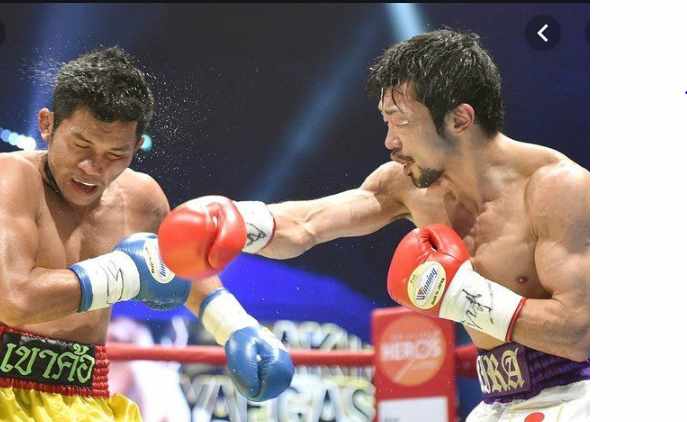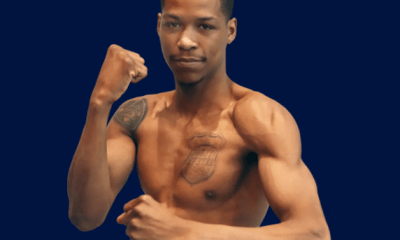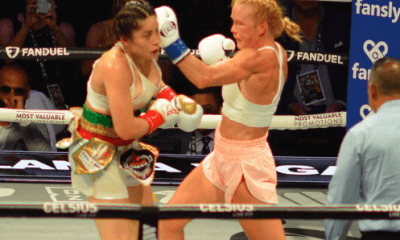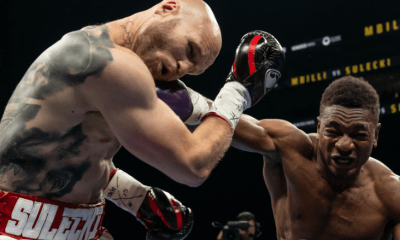Featured Articles
Looking for the Fight of the Decade? Start Your Search at 105 Pounds

Looking for the Fight of the Decade? Start Your Search at 105 Pounds
Boxing is like any other product in that you must follow the money to understand how it works – but there is no unified theory, and for good reason. The rules that govern the money at heavyweight are not the same as the rules that govern the money at 105lbs, strawweight, minimumweight, once even “gnatweight”, the much maligned often-named smallest of all the divisions. It is no coincidence that the failure of Deontay Wilder and Anthony Joshua to meet during their dual “reigns” over their division holds the temporal record. Such profligacy in the lower divisions would be unthinkable. As a general rule (for all that it’s currently being flouted by divisional number one, Wanheng Menayothin), the top men at 105lbs can’t afford to duck each other. Economics dictates that they must meet. As we shall see, even this does not guarantee riches.
As the 2010s run out and the fight of year argument is subsumed in the fight of the decade argument, most of the best contests at 105lbs will be ignored. That’s unfair because 2010-2019 has seen some wars, two of which are stuck on contenders for the decade’s number one spot. Here then, we take a look at three of the most splendid matches made at the 105lb limit in the past decade. Footage from each is linked in the clickable sub-heading for each of the three entries.
Pornsawan Porpramook Vs Akira Yaegashi, October 2011
Akira Yaegashi, out of Kanagawa, Japan, would have a serious part to play in the machinations of the lower weight division and its most famous denizens throughout the decade, but back in 2011 he was just another Japanese boxer carrying a mediocre 14-2 record.
Against Pornsawan Porpramook, a Thai, he would be given the opportunity to prove he was something else. Porpramook (aka Somporn Seeta) had been a hot ticket in the 2000s but had come to a juddering halt when he reached title level, then surprised in overturning beltholder Muhammad Rachman in what seemed his last chance. Yaegashi would be his first defense and their combat would be one of the most extraordinary fights of this or any other decade.
The two were careful early, Yaegashi especially, circling while ruling with the most gorgeous and varied series of two-piece left hands; uppercut body/head; uppercut/left hook; double jab; hook down/up, up/down. Porpramook was set adrift by those punches.
Adrift, but making determinedly for shore. He couldn’t quite cut the ring off on Yaegashi but he was able to catch him for fleeting moments and make him pay. He out-roughed and out-manned his challenger in those moments and Yaegashi, as would be demonstrated often in his late career, suffered from the dangerous and wonderful disease of machismo every bit as much as his Mexican counterparts. In spells, he began to meet and match Porpramook.
This all crystallised in round seven. This may or may not be the fight of the decade, but round seven was almost certainly the round of the decade; the two just stood in the pocket and traded for three minutes. There were no clinches. Nor was it inexcusably wild. It was just two men stood toe-to-toe trying to outthink each other. Again and again Yaegashi seemed on the verge of taking over – but Porpramook boxed incessantly, to the rhythm of a metronome only he could hear, slower than Yaegashi’s but unshakable. When the Japanese hit him with four thudding jabs in a row, the Thai gave him a quick nod of respect and went back to work.
Most natural would have been for both men to seek rest in the eighth – instead, they did it again and it remains one of the most absurd, terrible, beautiful things I’ve seen in the boxing ring. Yaegashi dominated while Porpramook waved him in. Then Porpramook landed a winging right hand and Yaegashi seemed, momentarily, ready to go. They ended a round that seemed to last six minutes tossing exhausted bombs ring center.
It couldn’t last, and it didn’t. In the tenth, Porpramook finally succumbed, rescued on his feet by the referee even as he tried to reorganize behind the jab and come again.
It’s a fight that is remembered, but had it been staged in Las Vegas between two western middleweights it would be talked about by boxing fans for a hundred years; as it is the linked footage of round seven currently has fewer than 5,000 views.
Francisco Rodriguez Jr. V Katsunari Takayama, Aug 2014
For a short while during the past decade, Francisco Rodriguez Jr, out of Monterrey, Mexico, was the single best bet for making a great match. The kid came to fight, and within him beat the heart of a true Mexican. Rodriguez may have backed up occasionally, but it was only to bait his opponent onto a volley of sure punches.
Defensive flaws and a good chin guaranteed action packed rounds and in the shape of Japanese whirlwind Katsunari Takayama he found his perfect foil. Arguably the world’s best 105lb fighter at the time of the contest, Takayama was also a volume puncher par excellence with the engine to make the nightmare real. No puncher, he overwhelmed opposition with sheer activity, forcing them to move, or trade.
Rodriguez chose trade.
Takayama literally ran from his corner at bell and the pattern for the fight was immediately determined: Takayama would move and flurry, Rodriguez would establish powerful left hooks upstairs and the two would share auspices to the body. The balance of combat here is exquisite. Takayama will take a lead by virtue of his superior footwork. Rodriguez must endure but while he is enduring he must sap Takayama’s strength, knowing, as he does, that Takayama can complete twelve rounds at this pace if he is unfettered – the benefit of carrying barely more than a hundred pounds to the ring – but not if he, Rodriguez, can execute punishment severe enough to bring him down off his toes and into a Mexican wheelhouse.
Rodriguez found him late in the second, uppercut and a right hand, the punch he needed to establish to win the fight. The steam Takayama answered with in the third spoke of his awareness but the left hook he walked on to for a flash knockdown made the fight a desperate one from the fourth.
There are no rounds less than scintillating in this fight, but of the those remaining, the sixth may be the most interesting and in it there are echoes of the seventh and eighth between Ponpramook and Yaegashi. Rodriguez tries to establish a pace as quick as Takayama’s, to take away his volume advantage and for one minute he rules the fight. All the while, Takayama continues to deploy his punches as in the first five rounds and when Rodriguez, fighting at a pace unnatural to him, inevitably, wilts, Takayama once more takes control. Here the fight is won. Rodriguez must return to his left-hook heavy offense, lighter in number but heavier in artillery and nothing like enough to close the gap.
These are the two vintage 105lb displays from the decade and were it not for the rivalry between Rafael Marquez and Israel Vazquez, they arguably would have been number one and number two at any weight for this century.
Oswoldo Novoa vs Wanheng Menayothin, November 2014
As noted above, the current 105lb number one, Wanheng Menayothin, is shirking the top challenges within the division, but as challenger, he did not have that luxury. The beginning of his stewardship of his alphabet strap of choice began back in November 2014 with victory over the Mexican, Oswoldo Novoa. Novoa was the weakest of the 105lb strapholders and to tempt him out to Thailand to meet Menayothin, his promoter broke the bank – with a tiny purse bid of $170,000. Keep in mind that to pull the same trick up at heavyweight, Anthony Joshua’s promoter had to pay Charles Martin an eye watering $5,000,000.
Fight fans who tracked this one down though, were rewarded with a spectacle. Not the equal of the two above wars, this was a high-class squabble from first to last, filled with surging exchanges and a ceaseless quest for dominance on behalf of both men.
Menayothin has rarely ventured into the top ten for opposition for his own defenses, but here, against the world’s then number six, he proves the more compact, more technically assured fighter and hinted at the beginnings of something really special.
Novoa became increasingly desperate but he never shirked the brawl, even when in the eighth and ninth he started to ship three and four punch combinations instead of single shots; even when his strength abandoned him and Menayothin was able to lay upon him and work ceaselessly.
Novoa’s corner finally pulled him from the contest, but for all that the concluding rounds were edging towards one-sided, his resistance, and the fight, remained stirring.
As 2019 trickles into 2020, the 105lb decade promises much and hopefully will deliver its fair share. Missing these fights is all too easy with matches made in far-flung cities at all hours of the day and night but perseverance can bring reward – certainly one for noting is the possible match between Menayothin and Thammanoon Niyomtrong, the legitimate pretender to the number one throne and a man who shares his nationality if not his promoter.
Should it come off it will be a legitimate superfight east of India and more than likely a contender for all those “fights of the decade” lists you may choose to wade through in ten years.
Have a happy New Year.
Check out more boxing news on video at The Boxing Channel
To comment on this story in The Fight Forum CLICK HERE
-

 Featured Articles3 weeks ago
Featured Articles3 weeks agoAvila Perspective, Chap. 330: Matchroom in New York plus the Latest on Canelo-Crawford
-

 Featured Articles1 week ago
Featured Articles1 week agoVito Mielnicki Jr Whitewashes Kamil Gardzielik Before the Home Folks in Newark
-

 Featured Articles4 weeks ago
Featured Articles4 weeks agoAvila Perspective, Chap 329: Pacquiao is Back, Fabio in England and More
-

 Featured Articles3 weeks ago
Featured Articles3 weeks agoOpetaia and Nakatani Crush Overmatched Foes, Capping Off a Wild Boxing Weekend
-

 Featured Articles2 weeks ago
Featured Articles2 weeks agoCatching Up with Clay Moyle Who Talks About His Massive Collection of Boxing Books
-

 Featured Articles3 weeks ago
Featured Articles3 weeks agoFabio Wardley Comes from Behind to KO Justis Huni
-

 Featured Articles4 weeks ago
Featured Articles4 weeks agoDelving into ‘Hoopla’ with Notes on Books by George Plimpton and Joyce Carol Oates
-

 Featured Articles1 week ago
Featured Articles1 week agoMore Medals for Hawaii’s Patricio Family at the USA Boxing Summer Festival





















